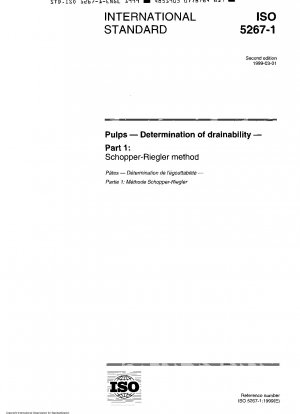ISO 5267-1:1999
Pulps - Determination of drainability - Part 1: Schopper-Riegler method
- Standard No.
- ISO 5267-1:1999
- Release Date
- 1999
- Published By
- International Organization for Standardization (ISO)
- Status
- Replace By
- ISO 5267-1:1999/cor 1:2001
- Latest
- ISO 5267-1:1999/cor 1:2001
- Scope
- This part of ISO 5267 specifies a method for the determination of the drainability of a pulp suspension in water in terms of the Schopper-Riegler (SR) number. The Schopper-Riegler test is designed to provide a measure of the rate at which a dilute suspension of pulp may be dewatered. It has been shown that the drainability is related to the surface conditions and swelling of the fibres, and constitutes a useful index of the amount of mechanical treatment to which the pulp has been subjected. In principle, this method is applicable to all kinds of pulp in aqueous suspension. However, in practice, the Schopper-Riegler test provides acceptable results only if a sufficiently dense mat of fibres is formed on the wire screen. For this reason, the test is not recommended for some extremely short-fibred pulps, such as those from well-beaten hardwoods, as most of the fibres will pass through the wire screen, resulting in anomalous reduction of the SR number. The most reliable results are obtained within the range of 10 to 90 SR number. The results of this test do not necessarily correlate with the drainage behaviour of a pulp material on a commercial paper machine. NOTE A method for the determination of drainability in terms of the "Canadian Standard" freeness number is specified in ISO 5267-2:1980, Pulps — Determination of drainability — Part 2: "Canadian Standard" freeness method.
ISO 5267-1:1999 history
- 2001 ISO 5267-1:1999/cor 1:2001 Pulps - Determination of drainability - Part 1: Schopper-Riegler method; Technical Corrigendum 1
- 1999 ISO 5267-1:1999 Pulps - Determination of drainability - Part 1: Schopper-Riegler method
- 1979 ISO 5267-1:1979 Pulps; Determination of drainability; Part 1 : Schopper-Riegler method
